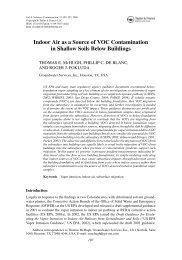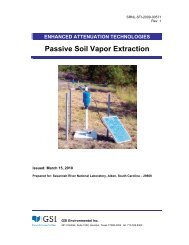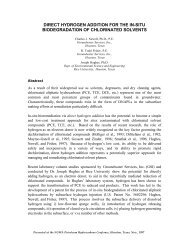Calculation and Use of First-Order Rate Constants for Monitored ...
Calculation and Use of First-Order Rate Constants for Monitored ...
Calculation and Use of First-Order Rate Constants for Monitored ...
You also want an ePaper? Increase the reach of your titles
YUMPU automatically turns print PDFs into web optimized ePapers that Google loves.
Effect <strong>of</strong> Source Decay (k source) on Concentration vs.Time Pr<strong>of</strong>ilesThe figures below show concentration vs. time pr<strong>of</strong>iles <strong>for</strong> various source decay rates <strong>for</strong> both the source <strong>and</strong> downgradient locations.This scenario was run using the Bioscreen model (Newell et al., 1996) assuming a longitudinal dispersivity <strong>of</strong> 100 ft, no sorption <strong>and</strong>no biodegradation. The maximum concentration is shown to be inversely proportional to the source decay rate. (Note the two graphshave different scales.)87k source =0Concentration (mg/L)65432kk source =0.069 per yrsource =0.0139 per yrk source=0.139 per yrk source =0.346 per yrk source=0.693 per yrNear source location100 5 10 15 20 25 30 35 40 45 50Time (yr)3k source=0Concentration (mg/L)21kk source =0.069 per yrsource=0.0139 per yrk source =0.139 per yrk source =0.346 per yrk source=0.693 per yrDowngradient location00 5 10 15 20 25 30 35 40 45 50Time (yr)24






